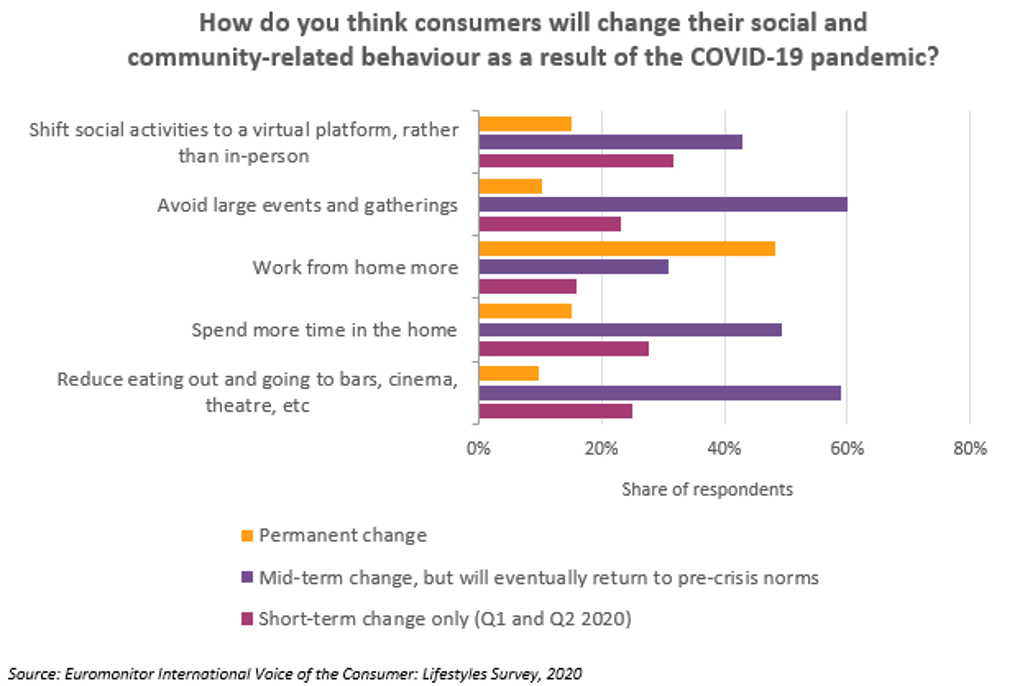The pandemic fundamentally changed our relationship with the home. With home sizes trending smaller and with a myriad of activities expected to continue at home, the future home will be designed with the versatility of space in mind. Being able to use the same space for multiple activities will be critical.
According to Google’s mobility data, in the last 18 months, consumers spent 20-30% more time at home than the year before. Not only is this unprecedented, but with work cultures evolving to incorporate work from home routines, this is likely to be a lasting trend. For many people, the pandemic has fundamentally changed their relationship with their homes.
During the pandemic, the home became a “hygienic sanctuary” for consumers under lockdown orders. Not being able to leave home, consumers converted their homes into indoor gyms, gourmet kitchens, home cinemas and home offices.
After the pandemic, many of these habits are expected to persist. Euromonitor’s Voice of the Consumer: Lifestyles Survey, 2020 shows that consumers want a hybrid work from home and office arrangement. This gives consumers the ability to continue their lives with the home as a focus point.
We have identified 8 aspects to a future home that are becoming more important for consumers and the goods and services catering to them:
The Smart Home
The concept of a smart home is evolving. Starting with homes containing devices operating in their own silos, companies have continuously worked to integrate these devices and ecosystems into one common platform. The smart home will be the brains of the future home. These will be connected to smart cities and private companies that will provide consumers with value-added services.
The Automated Home
As consumers are expected to spend an increased amount of time at home, convenience has become a core focus. Consumers want to enjoy quality of time at home, with automated systems taking care of household chores. Thus, automated homes will be a central focus of the future home.
Hygiene
Who owns hygiene is an important strategic question. It marks the end of Lister and 150 years of dominance of chemistry as the core domestic response. Already in 2021, we observe a proliferation of technology-based hygiene responses involving filtration, UV-C, UV-B, ionisation, steam etc.
Beyond the application of physics, we also appear to be on the cusp of a surge of investment in an organic approach to hygiene. Future home hygiene will not be about throwing ever-larger quantities of energy, chemicals, and filtration at a problem but innovative low energy, targeted and even predictive solutions.
Sustainability
The future will be dominated by scarcity of resources and the pursuit of mitigating the impact of this scarcity on life. In the case of the future home this will point to the adoption of new technology (typically offering improved efficiency) which will ultimately support more sustainable lifestyles.
The most significant contribution to sustainability from the future home will come from its evolution from uneasy compromise to one where sustainability wins out as being the best solution. There is much evidence to indicate we are at an inflection point, where market forces combine and act in the service of sustainability.
Time
Time in the context of the future home is a critical question. Just how sticky will the stay-at-home culture continue to be? Prevailing sentiment suggests that consumers on the whole expect – and want, in many cases – to spend more time at home than they did pre-pandemic.
One thing is for sure – wherever we are spending it, time will always remain a luxury, meaning that products and services which offer time savings will be in ever-increasing demand. The big challenge for the future home will be to deliver without the traditional performance and result compromises which tend to typify the “quick” of today.
Space
Physically, where homes are distributed is changing; in the developed world there are examples where the pandemic has brought the prospect of de-urbanisation in major cities like London. Similar to the discussion around time, just how sticky these trends will be longer-term is a key part of the discussion around the future home.
Competition for space within the home will heat up over time; which products are needed? which new products will we make room for? which will be replaced by services or superseded by access over ownership business models.
Health
As a confluence of activities have become homebound, consumers are increasingly aware that they must stay healthy at home. Starting with physical exercise, consumers have sought to include at least one piece of exercise equipment at home.
Mental health at home will be equally important; future homes will incorporate aspects to help consumers cope with stress, manage emotions and provide emotional support from family and friends.
The future home will be an integration of all these aspects and more, using machine learning and AI. It is probably not far-fetched to say that our future homes could also be our health hubs.
Care
Advances in medical technology have led to a radical shift in home-based care. For patients, the ability to recuperate at home is a relief. For hospitals, it helps free up space for other patients. The target for care in the future home will focus not only on adults with chronic conditions but also rural homes and patients of all ages with chronic diseases.
In the past, ageing in place has focused on reducing physical risk in the home using aids to prevent incidents such as falls or fires. In the future home, mental wellbeing will be just as important. The future home could turn out to be the companion home as well.
The future home is an evolving idea. The idea is not fixed in stone and advances in technology will lead to changes in the concept. However, the likely success of any iteration of the future home will depend on consumer willingness to share data with companies and governments.

